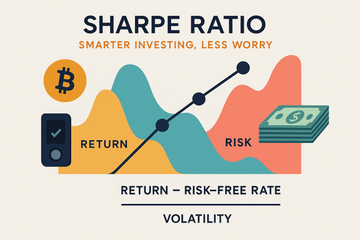Let’s be honest—most folks’ eyes glaze over at the mention of investment metrics. But stick around because the Sharpe Ratio isn’t just some dusty math formula cooked up in a distant economics lab. Actually, it’s a game-changer for anyone who cares—just a little—about the balance between making money and not losing sleep at night. Whether you’re stacking sats with Bitcoin, browsing altcoins, or just curious how crypto hardware wallets like Trezor and Ledger play into risk management, understanding the Sharpe Ratio gives your financial decisions a hidden edge.
What’s the Big Deal? Risk vs. Reward, Plain and Simple
Let me explain. Imagine you’re at a bustling farmer’s market, choosing between two honey jars. Both promise the sweetest taste, but one comes from a reliable local beekeeper and the other, a mysterious truck in the alley. Which one do you try? The trusted jar offers tasty rewards and peace of mind, while the random one could be a thrill—or a disaster. That’s your classic risk-reward dilemma. The Sharpe Ratio helps sort out these choices with numbers, not just gut feelings.
Sharpe Ratio in a Nutshell: No Fancy Math Degree Needed
Here’s the thing. The formula goes like this:
- Sharpe Ratio = (Average Return of Investment - Risk-Free Return) / Standard Deviation of Return
You don’t have to memorize the numbers. What matters is the story they tell. A higher Sharpe Ratio? That means you’re getting better returns for the risk you’re taking. Lower ratio? Not so hot—you’re taking on more risk without much reward. It’s like picking that honey jar with zero trace of weird aftertaste.
Crypto, Stocks, or Soybeans? The Ratio Doesn’t Discriminate
While Wall Street types love to throw Sharpe Ratios around, this concept easily hops into the world of cryptocurrencies. Ever felt like you’re on a rollercoaster when checking your portfolio on your Ledger or Trezor wallet? Prices soar only to nosedive a moment later. The Sharpe Ratio helps cut through that noise. Instead of simply chasing high returns, it makes you pause and ask: “Am I being paid fairly for this risk? Or am I just gambling in disguise?”
Let’s Get Real: Numbers Meet Human Feelings
Now, numbers are cold. But behind every calculation is a real person—maybe you, maybe your friend teenager who just can’t stop talking about Bitcoin. A low Sharpe Ratio isn’t just a statistical flag; it could mean more worry-filled nights and shaky confidence in your investments. Don’t we all want a little peace of mind with our profits?
Digging Deeper: What’s Hiding Behind Those Numbers?
So, you’re fiddling with crypto, maybe parking your tokens on a cold storage device. You check CoinGecko, see some fat percentage gains, and think you’ve cracked the code. Hold your horses. If those gains come with massive mood swings (read: price volatility), your Sharpe Ratio shrinks. Sometimes, steady really does win the race. Think of stablecoins compared to memecoins—the flash is there, but is it worth the risk?
- A high Sharpe Ratio often points to savvy investing, not just lucky streaks.
- A low or negative ratio? That might whisper, “Maybe rethink this strategy…”
And just a quick word about comparing apples to oranges: try weighing ratios for similar asset types. Benchmarking your Ethereum against T-bills? That’s like comparing fireworks to candles.
Sharpe Ratio’s Little Surprises: It’s Not Perfect
Honestly, few things in finance are one-size-fits-all. The Sharpe Ratio has blind spots. Like what? Well, it dresses up volatility as always being risky. Sometimes, that’s not the full picture—some ups and downs might be just noise. Or, take Black Swan events. The formula doesn’t see them coming, but you’ll remember if your portfolio is suddenly worth half. And for crypto folks, wild price swings can make the ratio bounce around like a pogo stick.
Don’t toss out the metric, though. Just remember it’s one tool, not the entire toolkit. Combine it with your research, gut feeling, and maybe some old-fashioned common sense. Ledger and Trezor might protect your coins, but tools like the Sharpe Ratio help protect your sanity.
How Do Everyday Investors Actually Use This?
Professional analysts? They adore this stuff. But regular investors can tap in too. You don’t need Bloomberg terminals. Plenty of platforms and tools break down Sharpe Ratios for ETFs, mutual funds, and even some crypto products. Say you’re choosing between a crypto index fund and tracking your own coin portfolio. Track those Sharpe Ratios for a month or two. Surprised by the results? Sometimes, lower drama means higher returns—who knew?
Some folks even use the ratio to set personal investment boundaries. “If my Sharpe Ratio drops below one, maybe it’s time to rethink.” That little rule can save you from chasing returns you’ll regret later. Setting expectations matters as much in finance as it does in relationships (yeah, you heard it here).
What About the Future? Sharpe in the Age of DeFi and AI
The crypto crowd is already tweaking the classic Sharpe Ratio. New versions, like the Sortino Ratio, zero in on downside risk. And with AI-bots scanning the blockchain for arbitrage, some traders are combining old-school wisdom with cutting-edge automation. The basics still ring true, though: risk and reward forever dance together, sometimes clashing, sometimes gliding.
Bottom Line: Don’t Bet Blind
Next time you size up an investment—be it a time-tested index, a spiky crypto, or that enticing high-yield fund your friend won’t shut up about—ask yourself: What story does the Sharpe Ratio tell? Sure, it’s not a fortune cookie. But it just might stop you from making a decision you’ll second-guess into the wee hours. After all, isn’t the goal to grow your stash while also sleeping just a bit easier? Risk and reward aren’t enemies. With metrics like this, they’re simply two sides of your investing coin.











